Connecting the Dots – A Beginner's Guide to Constellations
Why Understanding Constellations in the Sky Connects Us to Something Bigger
Constellations in the sky are officially defined regions of the celestial sphere that contain groups of stars forming recognizable patterns, with 88 constellations recognized by the International Astronomical Union covering the entire night sky.
Quick Facts About Constellations:
- Total number: 88 official constellations (36 northern, 52 southern)
- What they are: Regions of sky with precise boundaries, not just star patterns
- Visibility: Changes with seasons, location, and time of night
- Best viewing: Dark skies away from city lights
- Key difference: Constellations are official sky regions; asterisms are informal star patterns
Whether you're standing on a beach looking up at Orion's Belt or trying to find the Big Dipper from your backyard, these star patterns have guided humans for thousands of years. Ancient cultures used them for navigation, timekeeping, and storytelling - connecting the dots between stars to create meaningful shapes and stories.
But here's what's fascinating: the stars in most constellations aren't actually near each other in space. They just appear to form patterns from our viewpoint on Earth. It's like looking at city lights from an airplane - they seem connected, but they're really at different distances.
Today, astronomers use these same constellation boundaries as a celestial address system. Every star, galaxy, and nebula belongs to one of the 88 official constellations, making it easier to locate objects in the vast night sky.
I'm Suchi Jain Saxena, and while I've spent years scaling businesses in Silicon Valley and now run CustomCuff, I've always been drawn to how constellations in the sky connect us to something timeless and universal. There's something magical about looking up at the same star patterns that inspired ancient civilizations - and that same sense of wonder often drives people to seek meaningful keepsakes that capture life's most precious moments.
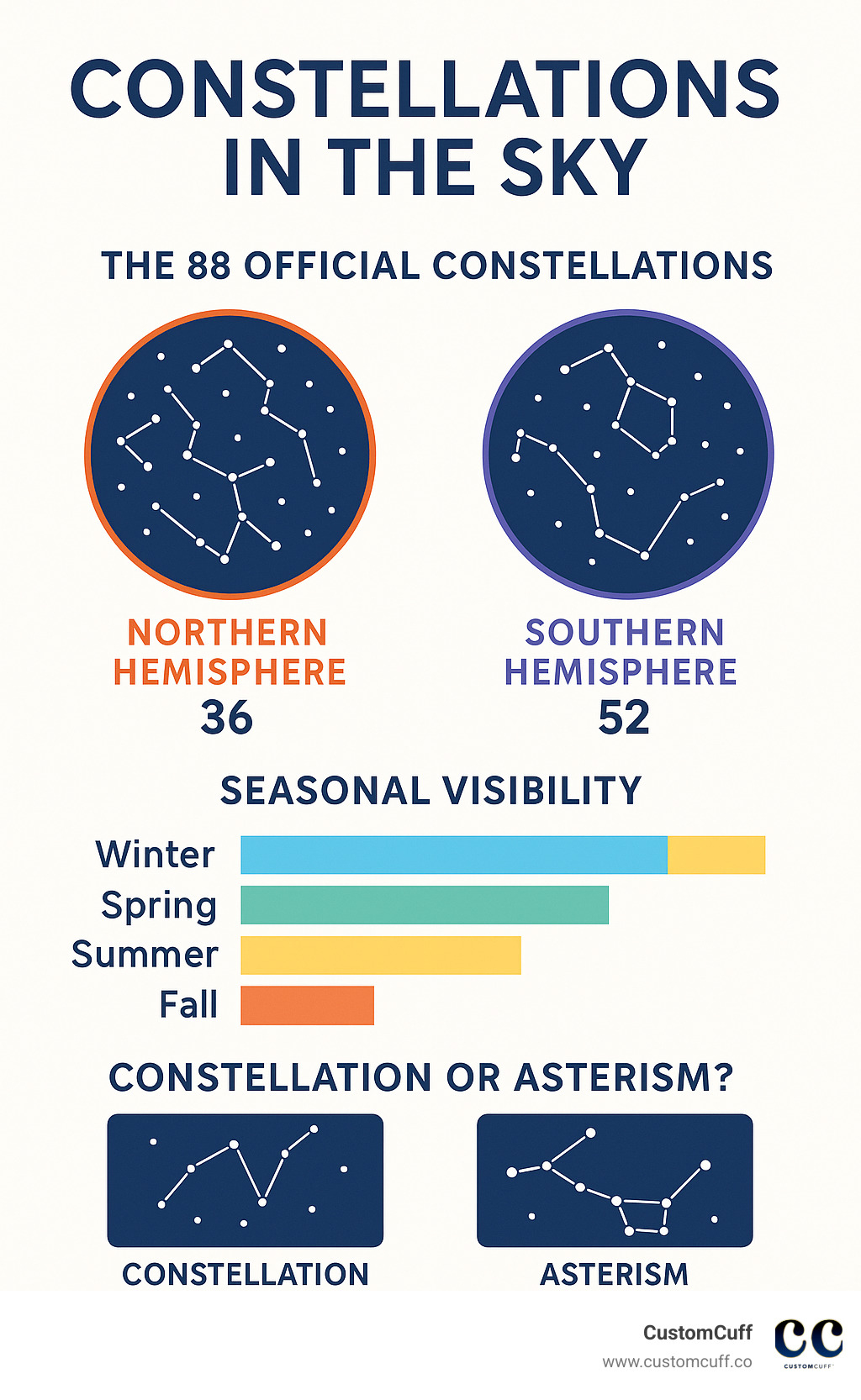
From Patterns to Celestial Real Estate: Defining Constellations
Imagine if someone asked you to divide up the entire night sky into organized sections, like creating a cosmic map with clear boundaries. That's exactly what astronomers did when they established our modern understanding of constellations in the sky.
Think of constellations as celestial real estate - each one is a specific region of the sky with official boundaries, much like how states or countries have borders on Earth. The International Astronomical Union (IAU) made this official in 1922 when they recognized exactly 88 constellations, then drew precise boundaries around each one in 1928.
These boundaries follow invisible lines called right ascension and declination - basically a cosmic grid system that covers every single patch of sky above us. This means every star you can see, no matter how faint, has a cosmic address and belongs to exactly one constellation.
But here's the fascinating part: this modern system builds on stories that are thousands of years old. The Greek astronomer Ptolemy cataloged 48 constellations way back in the second century, and many of those ancient star patterns are still the ones we recognize today. From Orion the Hunter to Ursa Major the Great Bear, these stellar stories have been passed down through generations.
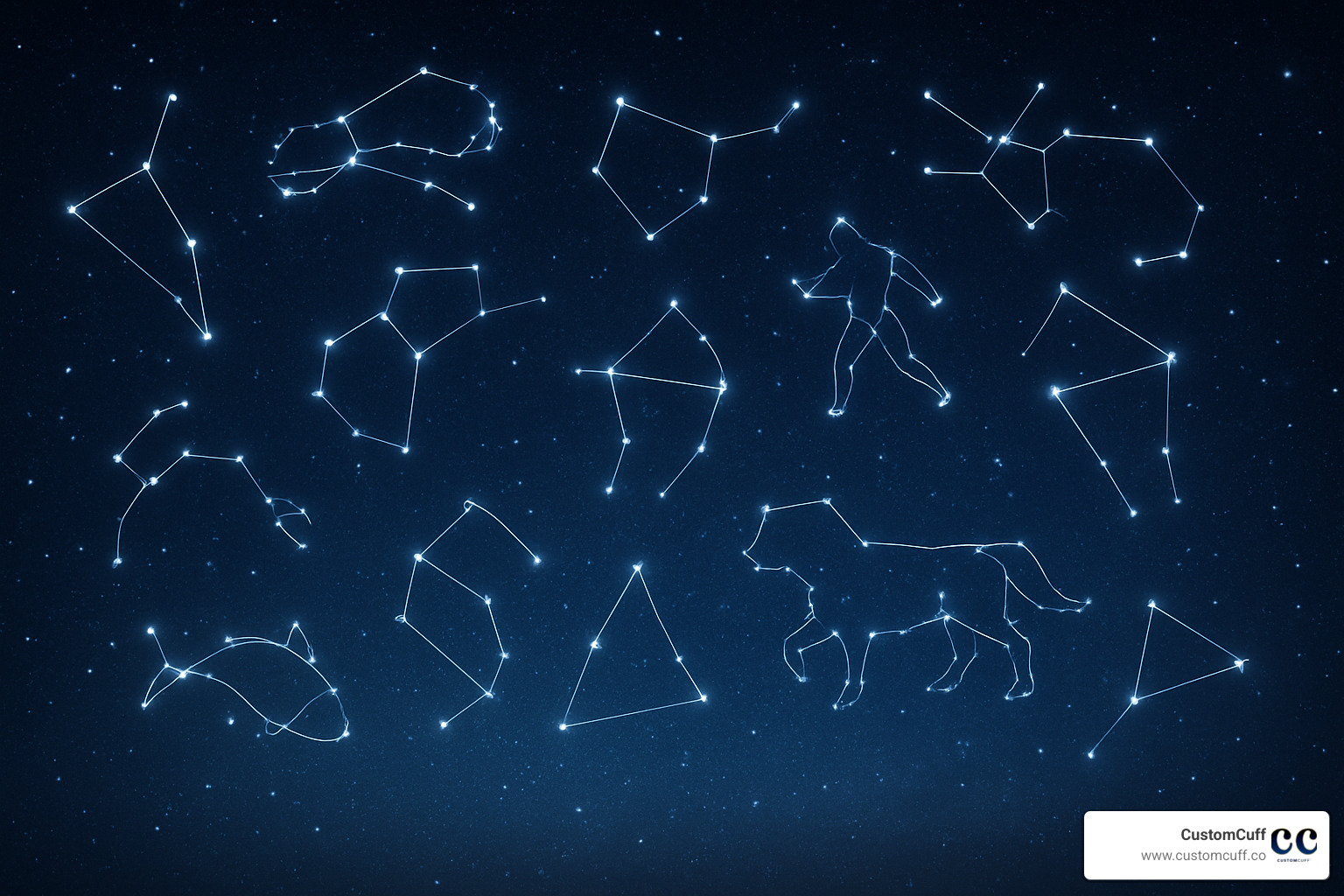
Stars within these cosmic neighborhoods get their names in several clever ways. The brightest stars often keep their traditional names - like Sirius or Betelgeuse - many of which come from Arabic astronomy. In 1603, a German astronomer named Johann Bayer started using Greek letters, so the brightest star in each constellation became Alpha, the second brightest Beta, and so on. Later, John Flamsteed simply numbered stars from west to east within each constellation.
Understanding constellations in the sky vs. asterisms
Here's where things get really interesting - and where most people get confused. Not every star pattern you recognize is actually a constellation. Many famous shapes in the sky are what astronomers call asterisms - recognizable star patterns that might span multiple constellations or represent just part of one.
The Big Dipper is probably the most famous example. It's not a constellation at all! It's actually an asterism within the much larger constellation called Ursa Major (the Great Bear). The seven bright stars of the Big Dipper are just the bear's back and tail.
Similarly, the Teapot that many people spot in summer skies is an asterism within the constellation Sagittarius. And the Summer Triangle that dominates warm-weather nights? It connects stars from three completely different constellations: Lyra, Cygnus, and Aquila.
This happens because our brains are naturally wired for pattern recognition. When we look up at the night sky, we can't help but try to connect the dots and see familiar shapes. Different cultures have seen completely different patterns in the same groups of stars - what we call the Big Dipper has been known as the Plough in Britain and the Wagon in Germanic traditions.
Star Names, Magnitudes & Catalogs
Understanding how stars are classified makes navigating constellations in the sky much easier. The magnitude scale measures star brightness, and it works backwards from what you might expect - the smaller the number, the brighter the star. A magnitude 1 star is about 2.5 times brighter than a magnitude 2 star.
But here's the tricky part: there's a huge difference between apparent magnitude (how bright a star looks from Earth) and absolute magnitude (how bright it would appear if all stars were the same distance away). Sirius looks like the brightest star in our night sky with an apparent magnitude of -1.46, but if you moved all stars to the same distance, it would only have an absolute magnitude of 1.42.
Meanwhile, Deneb in the constellation Cygnus appears much fainter to us but is actually one of the most powerful stars known. It's just incredibly far away - about 2,600 light-years compared to Sirius at only 8.6 light-years.
| Star | Apparent Magnitude | Absolute Magnitude | Distance (light-years) |
|---|---|---|---|
| Sirius | -1.46 | 1.42 | 8.6 |
| Deneb | 1.25 | -7.2 | ~2,600 |
| Polaris | 1.98 | -3.6 | 433 |
Modern star catalogs like the Smithsonian Astrophysical Observatory (SAO) catalog list over 250,000 stars, while the Hubble Space Telescope Guide Star Catalogue includes coordinates for over 19 million objects. These detailed catalogs ensure that every celestial object has a precise address in our cosmic neighborhood, making it easy for astronomers (and curious stargazers) to find exactly what they're looking for in the night sky.
Mapping the 88 Official Constellations in the Sky
Picture the night sky as a giant celestial map, divided into 88 distinct regions - each one an official constellation with precise boundaries. These constellations in the sky aren't randomly scattered across the heavens. Instead, they're carefully organized into 36 northern constellations and 52 southern constellations, creating a complete atlas of everything we can see above us.
What makes this even more fascinating is that 13 of these constellations form the zodiac - that special band of constellations in the sky where the Sun appears to travel throughout the year. You've probably heard of these: Aries, Taurus, Gemini, and the rest. They're like cosmic neighborhoods that our Sun visits on its yearly journey across the sky.
Some constellations hold VIP status because they never disappear from view. These circumpolar constellations circle around the celestial poles and stay visible all year long from certain locations. In the northern hemisphere, Ursa Major, Ursa Minor, Cassiopeia, Cepheus, and Draco dance around Polaris (the North Star) in an endless celestial waltz.
Here's something cool: the farther north you live, the more constellations become circumpolar for you. Someone in Alaska sees way more year-round constellations than someone in Florida. It's like having a bigger window into the cosmic show.
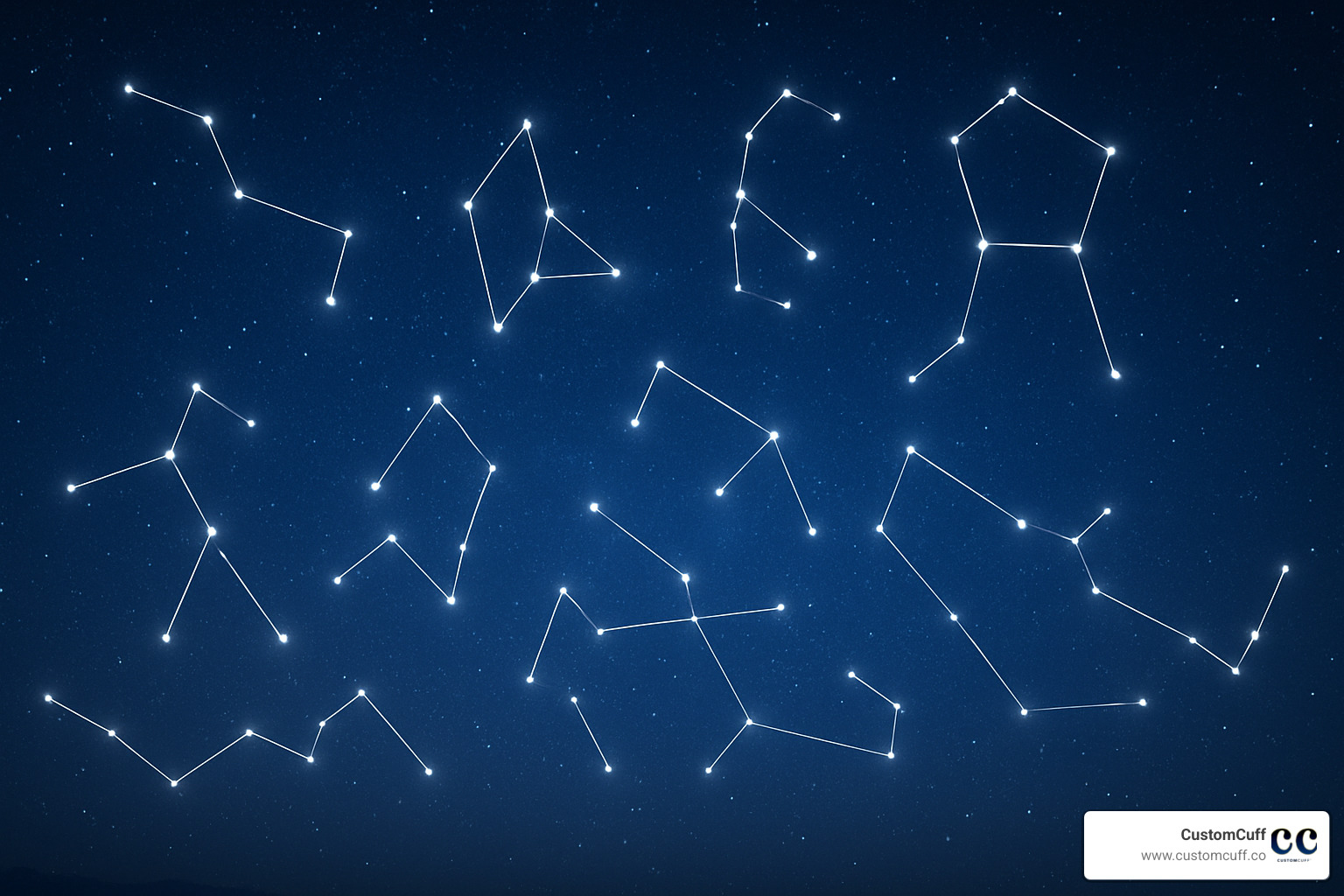
We can thank Belgian astronomer Eugène Delporte for bringing order to this celestial chaos. In the 1920s, he drew precise constellation boundaries along lines of right ascension and declination - basically creating cosmic property lines. Before his work, astronomers argued endlessly about which stars belonged to which constellations. Now every single star has an official address.
Constellations in the Sky grouped by season
Learning constellations in the sky becomes much easier when you think seasonally. Our planet's yearly dance around the Sun acts like a cosmic calendar, revealing different stellar neighborhoods throughout the year.
Winter brings us the superstar lineup, with Orion stealing the show. This season delivers some of the brightest and most dramatic constellations in the sky. The Winter Hexagon connects brilliant stars like Sirius, Procyon, Pollux, Capella, Aldebaran, and Rigel in a stunning geometric pattern. Winter's constellations shine so brightly because we're looking toward the outer edge of our galaxy, where young, hot stars burn with incredible intensity.
Spring ushers in Leo the Lion, with its distinctive Sickle asterism crowned by the bright star Regulus. This is also when Boötes takes center stage, featuring the orange giant Arcturus. Stargazers love the phrase "arc to Arcturus" - just follow the curve of the Big Dipper's handle and you'll land right on this brilliant star.
Summer unveils the famous Summer Triangle, connecting Vega in Lyra, Deneb in Cygnus, and Altair in Aquila. This season offers the most spectacular views because we're looking toward the center of our galaxy. The Milky Way becomes a glowing river across the sky, packed with star clusters and colorful nebulae.
Autumn welcomes Pegasus with its Great Square, alongside nearby Andromeda. This constellation hosts the incredible Andromeda Galaxy - the most distant object you can see with your naked eye at 2.5 million light-years away. Imagine - the light hitting your eyes left that galaxy when our earliest human ancestors were just learning to use tools.
This seasonal parade happens because stars rise about four minutes earlier each night. It seems tiny, but over a full year, this shift brings us back to the same stellar calendar we started with.
Constellations in the Sky classified by hemisphere & circumpolar status
Where you live on Earth completely transforms your view of constellations in the sky. The celestial equator acts like an invisible line dividing the heavens into northern and southern halves, and your latitude determines how much of each side you can peek at.
Northern hemisphere folks can see all the northern constellations plus a generous helping of southern ones, depending on how far north they live. Polaris serves as the ultimate reference point, sitting almost perfectly at the north celestial pole. Here's a neat trick: the height of Polaris above your horizon exactly equals your latitude. This simple relationship helped sailors steer the oceans for centuries.
Southern hemisphere observers get their own set of circumpolar constellations, though they don't have a bright pole star like Polaris. Instead, they rely on the Southern Cross (Crux) and nearby Centaurus for navigation. The Southern Cross appears on several national flags, showing just how important these constellations in the sky are to southern cultures.
If you're lucky enough to live near the equator, you hit the astronomical jackpot. Equatorial observers can see all 88 constellations throughout the year as the entire celestial sphere rotates overhead. That's why many major observatories choose locations near the equator - they get the full cosmic experience.
The interplay between your latitude and the horizon visibility creates a unique stellar fingerprint for every location on Earth. It's like having a personalized window into the universe, shaped by exactly where you call home.
Seasons, Location & How the Sky Changes
Picture this: you're looking up at Orion on a crisp January evening, and six months later, you can't find him anywhere. Did he disappear? Not exactly - he's still there, just hidden by the Sun's glare during summer days. This is the beautiful dance of constellations in the sky that's been happening for billions of years.
The night sky is like a giant clock that never stops ticking. Every night, stars rise about 4 minutes earlier than they did the night before. This happens because Earth takes 365.25 days to orbit the Sun, but only 23 hours and 56 minutes to rotate once relative to the stars (called a sidereal day). Those extra 4 minutes add up over months, gradually shifting which constellations dominate our evening sky.
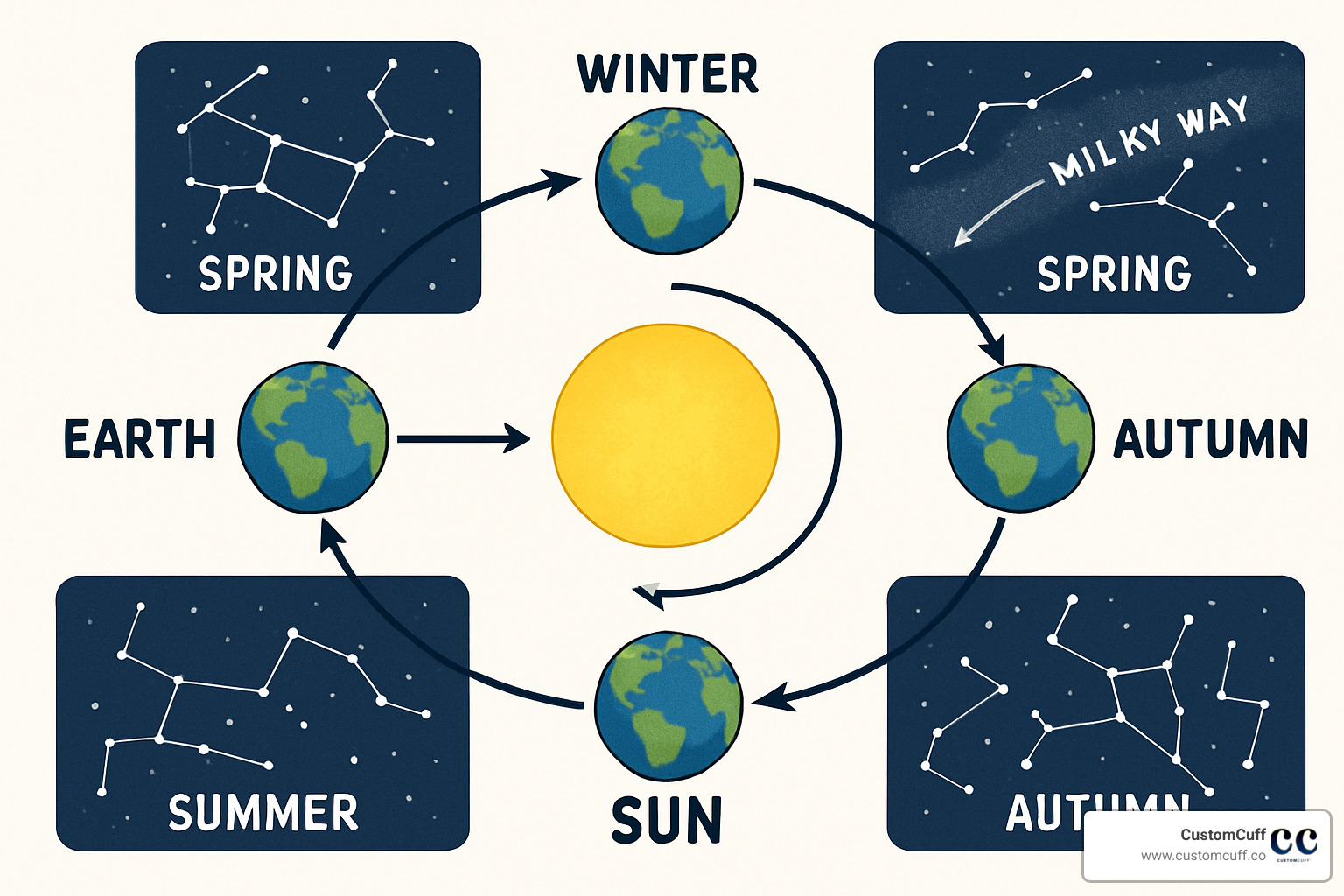
Think of it this way: in winter, Earth's nighttime side faces away from the center of our galaxy, giving us a view of brilliant individual stars and stellar nurseries like Orion's nebula. Come summer, we're looking toward the galactic center during our evening hours, which is why the Milky Way appears richest during warm nights. It's like having front-row seats to different parts of a cosmic theater throughout the year.
There's also something called precession happening - imagine Earth wobbling like a spinning top that's slowing down. This wobble takes about 26,000 years to complete, which means Polaris won't always be our North Star. Ancient Egyptians used a different pole star when they built the pyramids!
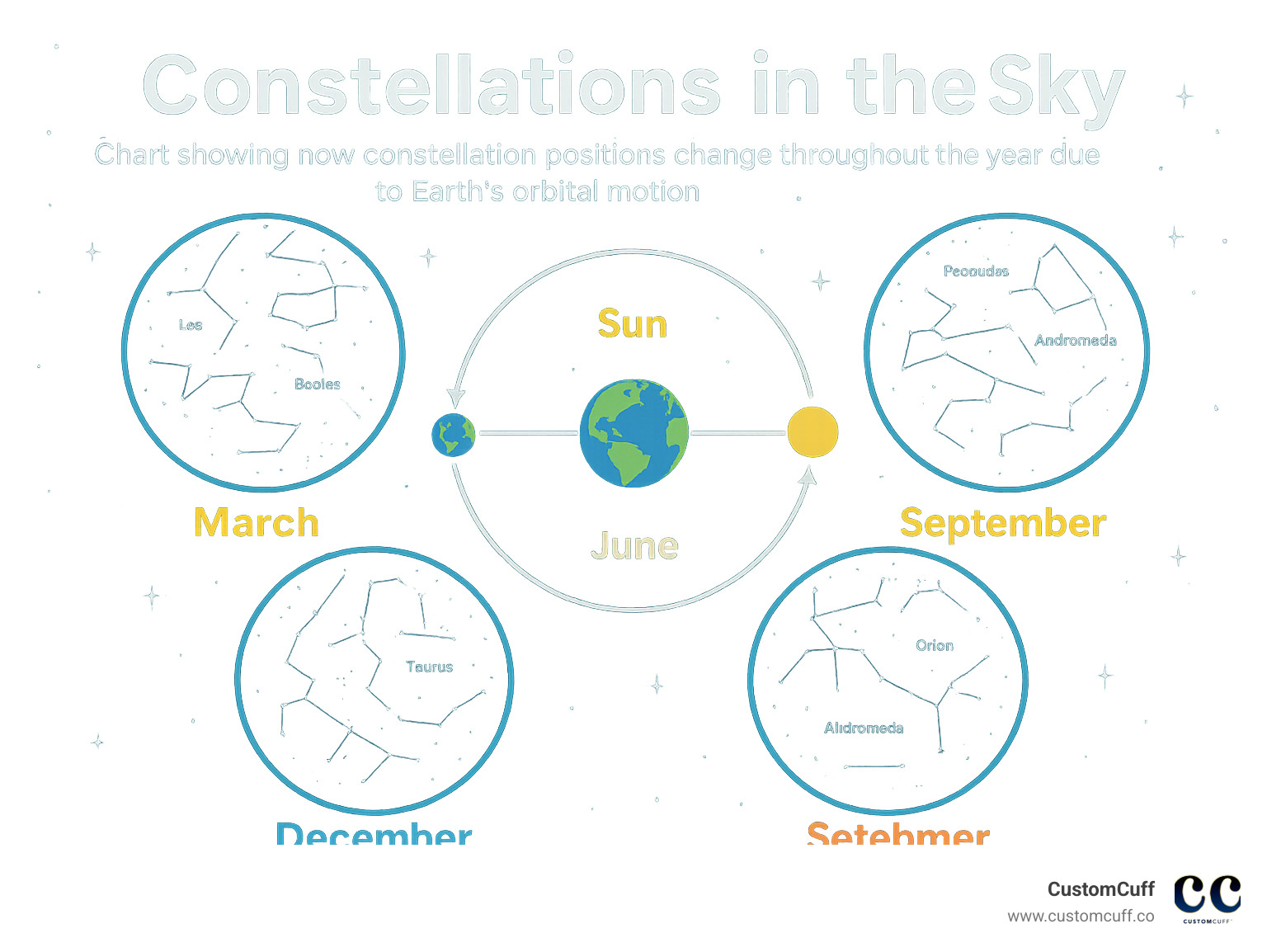
Using constellations for navigation & calendars
Long before GPS satellites and smartphone apps, constellations in the sky were humanity's original navigation system and calendar rolled into one. Sailors crossing dark oceans relied on star patterns to find their way home, while farmers used them to know when to plant crops.
The Big Dipper's pointer stars - Dubhe and Merak - became every northern sailor's best friends. Draw an imaginary line from Merak through Dubhe and extend it about five times the distance between these stars, and you'll land right on Polaris, the North Star. This simple technique gave travelers true north anywhere in the northern hemisphere.
Southern hemisphere navigators had their own stellar compass: the Southern Cross. Though smaller than its northern counterpart, this distinctive constellation points toward the south celestial pole when you extend its long axis about four and a half times its length.
Ancient farmers were equally clever with star timing. When the Pleiades cluster appeared in the evening sky, many cultures knew it was time for certain agricultural activities. The rising of Sirius told Egyptian farmers that the Nile would soon flood, bringing rich soil to their fields.
These practical needs gave birth to the constellation stories we know today. The Greek tale of Orion the Hunter, the Aboriginal Australian stories of the Emu in the Sky, and the Chinese legend of the Weaver Girl and Cowherd (represented by Vega and Altair) all served as memory aids. When survival depended on reading the stars correctly, storytelling became a vital educational tool.
Light pollution & why some constellations don't match their names
Here's something that frustrates many beginning stargazers: most constellations in the sky look absolutely nothing like their names suggest. You might stare at Leo for hours and never see a lion, or try to spot a microscope in Microscopium and come up empty. The problem isn't your imagination - it's light pollution.
Ancient astronomers could see 2,000 to 3,000 stars on a clear night. They connected dozens of faint stars to create their mythological figures. Today, from a typical suburban backyard, you might see only a few hundred stars. In city centers, that number drops to just the brightest few dozen.
Microscopium is the perfect example of this problem. Its stars are so faint that they completely disappear under even mild light pollution. What ancient astronomers saw as a delicate pattern resembling a microscope becomes invisible to modern eyes in most locations.
This is why those beautiful constellation charts in astronomy books often seem to bear no resemblance to what you actually see outside. The charts show all the stars that traditionally connect to form the patterns, but your eyes might only pick up the brightest anchor points.
Don't feel bad if you can't see elaborate mythological figures in the stars - you're not missing anything obvious. Even from dark sites, it takes considerable imagination to see a hunter in Orion or twins in Gemini. The key is learning to recognize the brightest stars and most obvious patterns first, then using those as stepping stones to find fainter treasures.
Organizations like the International Dark-Sky Association work tirelessly to preserve natural nighttime environments. They understand that our view of constellations in the sky is a natural heritage worth protecting - just like national parks or pristine wilderness areas. For more detailed sky charts and current visibility information, Heavens Above provides excellent resources for planning your stargazing sessions.
Spotting and Enjoying Constellations Tonight: Tools & Techniques
The best part about exploring constellations in the sky? You can start tonight with nothing more than your eyes and a bit of curiosity. While fancy equipment certainly has its place, some of my most memorable stargazing moments have happened during impromptu walks when I simply looked up and noticed something beautiful.
That said, a few simple tools can transform your constellation hunting from frustrating squinting to genuine findy. A planisphere is like having a personal sky guide in your pocket - this circular star chart adjusts for any date and time, showing you exactly which constellations in the sky should be visible when you hold it overhead. Think of it as a cosmic cheat sheet that never needs batteries.
For the tech-savvy stargazer, apps like Stellarium (free for computers) or SkySafari (for phones) offer the same guidance with extra features. Point your phone at the sky, and these apps identify constellations in real-time. Just remember to use the red-light mode to preserve your night vision.
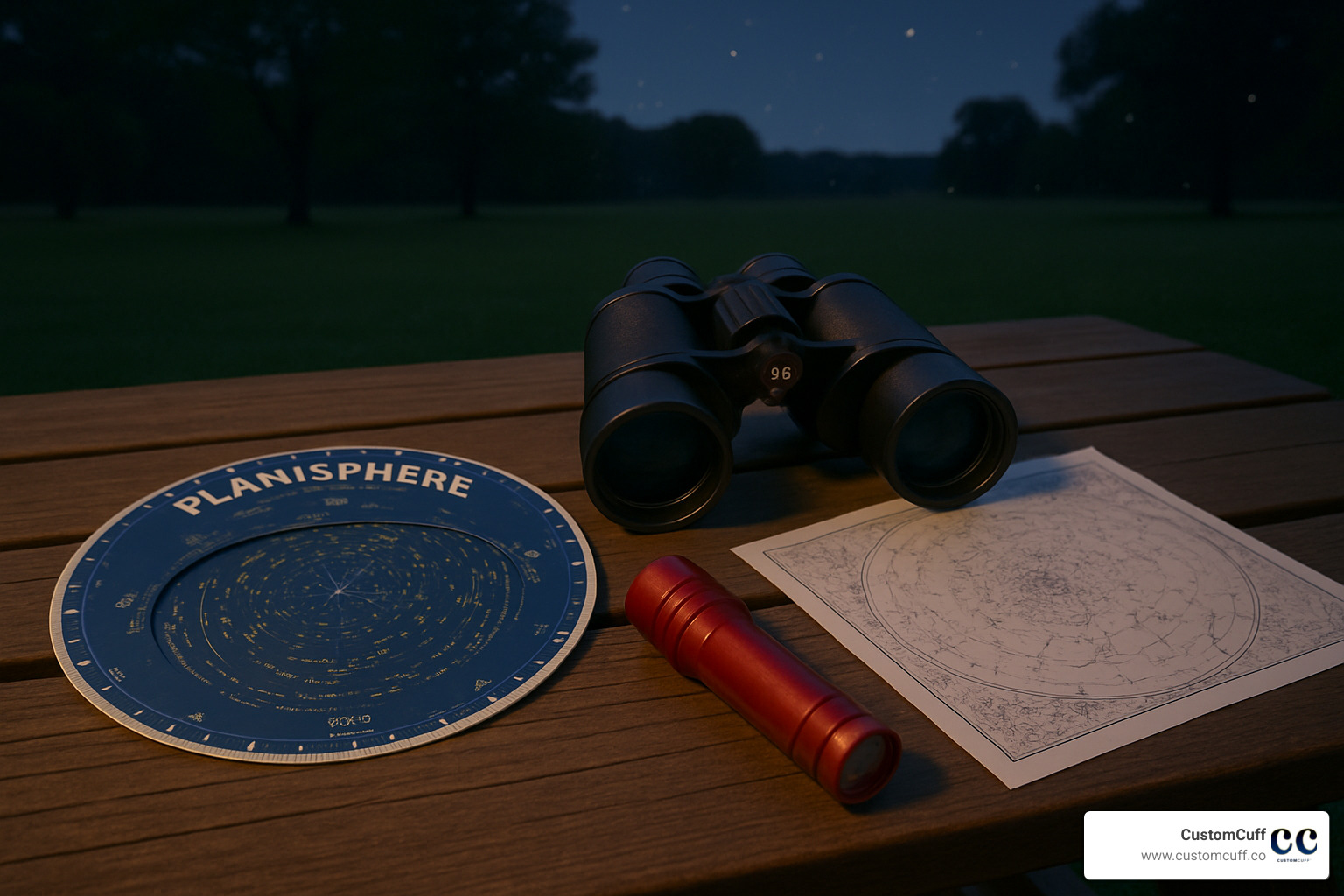
Binoculars make an incredible first upgrade from naked-eye viewing. A simple pair of 7x50 or 10x50 binoculars will reveal stars too faint to see otherwise, suddenly making constellation patterns pop into clarity. They're also much more user-friendly than telescopes - no setup required, and you can easily scan across the sky to explore different areas.
Here's a crucial tip that many beginners miss: get yourself a red flashlight for reading star charts. Your eyes need about 20-30 minutes to fully adapt to darkness, and even a quick glance at your phone's white screen can reset this process completely. Red light preserves your night vision while still letting you read charts and apps.
The biggest game-changer, though, is simply getting away from city lights. You don't need to drive hours into the wilderness - even a local park or beach can reveal dramatically more stars than your backyard. The difference between urban and suburban skies can be stunning.
Identifying constellations in the sky tonight step-by-step
Learning constellations in the sky is exactly like exploring a new neighborhood - start with the biggest, most obvious landmarks and work your way out from there. The Big Dipper serves as your celestial starting point because it's large, distinctive, and visible year-round from most northern locations.
Once you've spotted the Big Dipper, you've open uped your first navigation tool. Those two stars at the end of the Dipper's bowl - Dubhe and Merak - are called pointer stars for good reason. Draw an imaginary line from Merak through Dubhe and extend it about five times the distance between them. You'll land right on Polaris, the North Star, which sits at the end of the Little Dipper's handle.
The Big Dipper keeps giving. Follow the gentle curve of its handle away from the bowl, and you'll "arc to Arcturus" - a brilliant orange star in the constellation Boötes. Continue that same curved line to "speed on to Spica" in Virgo. This star-hopping technique connects familiar patterns to new findies.
Orion provides another fantastic starting point, especially during winter evenings. Those three bright stars in a neat row - Alnitak, Alnilam, and Mintaka - form Orion's belt and create one of the most recognizable patterns in the entire sky. Use the belt as your pointer: follow it down and left to find Sirius (the brightest star we can see), or up and right to locate the Pleiades star cluster, which looks like a tiny dipper made of diamonds.
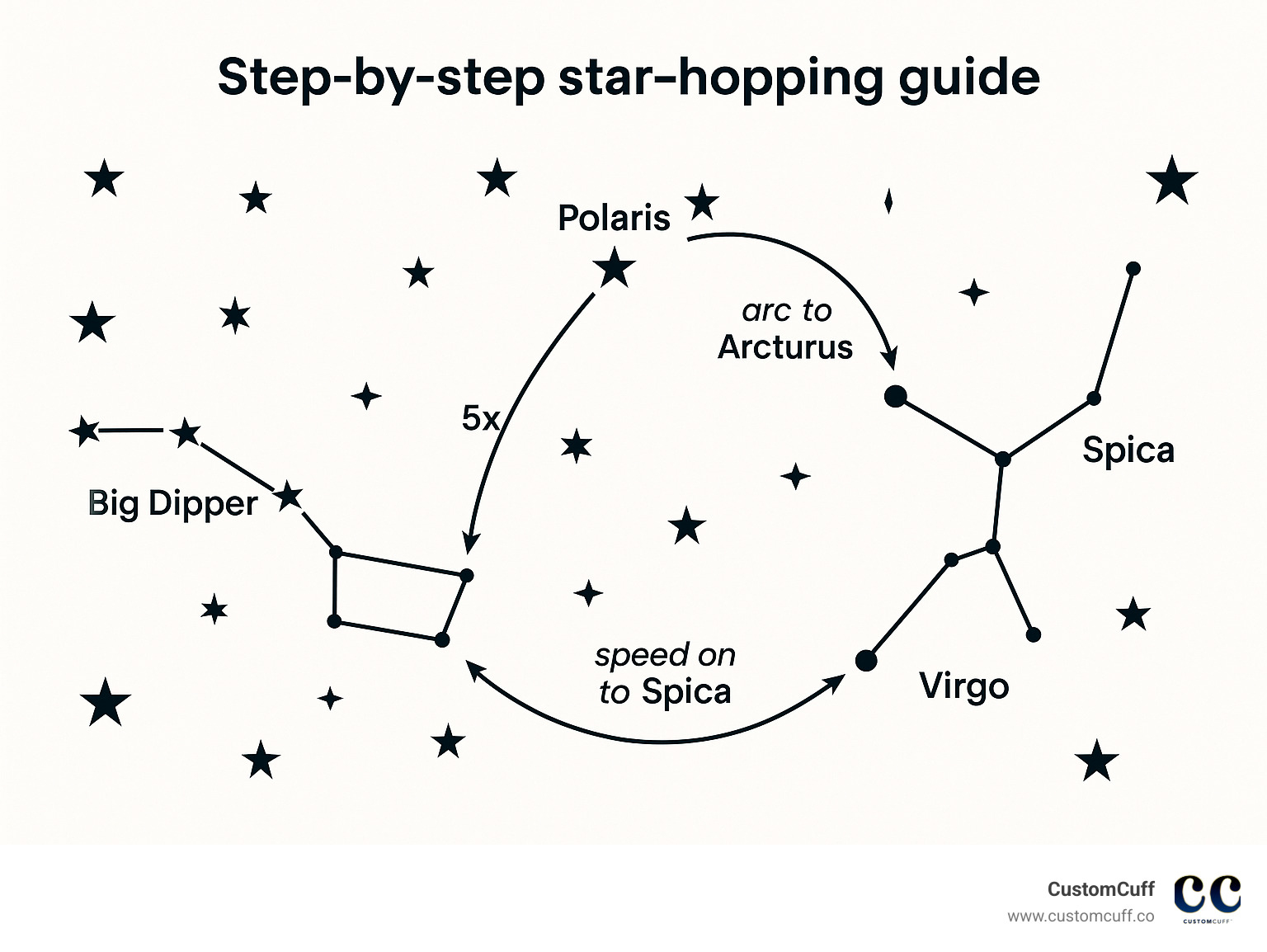
For your first deep-sky objects, try spotting the Orion Nebula - it appears as a fuzzy "star" hanging from Orion's belt like a sword. The Andromeda Galaxy shows up as a faint, elongated smudge in the constellation Andromeda (use Cassiopeia's distinctive W-shape to point you in the right direction). These objects represent some of the most distant things you can see with your naked eyes.
Resources & learning aids for beginners
The internet has revolutionized how we learn about constellations in the sky. Websites like Heavens-Above create personalized star charts for your exact location and time, showing precisely which constellations are visible right now from your backyard. It's like having a custom sky map created just for you.
Online planetariums let you practice constellation identification from the comfort of your computer. You can speed up time to watch how star patterns move throughout the night, or jump between seasons to see how different constellations in the sky dominate at different times of year. This virtual practice makes real-world stargazing much more successful.
Local astronomy clubs offer something you can't get online - hands-on guidance from experienced stargazers who know your local sky conditions. Many clubs organize star parties in dark-sky locations and loan telescopes to members. There's something special about having someone point out a constellation in person and share the stories behind it.
Mobile apps have made constellation identification almost effortless. Point your phone at any patch of sky, and apps like Star Walk or SkyView identify everything in real-time. While incredibly convenient, try to balance app use with traditional star chart reading - developing your natural navigation skills creates a deeper connection to the night sky.
For those who find themselves moved by particular celestial moments, consider how these experiences might be preserved as lasting keepsakes. More info about coordinates stories explores how specific star coordinates can commemorate meaningful times under the night sky, creating personal connections to the cosmos that last far beyond a single evening of stargazing.
Frequently Asked Questions about Constellations
When I first started exploring constellations in the sky, I had dozens of questions swirling around my head. After years of stargazing and helping others find the night sky, I've found that most beginners share the same curiosities. Let me address the questions I hear most often.
How many constellations can I see from my location?
Your latitude determines your celestial view more than anything else. From mid-northern latitudes around 40°N (think New York or Madrid), you can see about 60-70 of the 88 constellations in the sky throughout the year. If you're lucky enough to live near the equator, you'll eventually see all 88 constellations as the seasons change. Polar observers see fewer total constellations but enjoy more circumpolar ones that never disappear below the horizon.
Why do zodiac signs not match the actual constellations anymore?
This is one of my favorite astronomy facts to share! Earth's axial precession - essentially a slow wobble in our planet's rotation - has shifted everything over the past 2,000+ years. When astrology was first developed, the Sun appeared in Aries during the spring equinox. Today, it's actually in Pisces during that same time.
Here's another fun twist: astronomically speaking, there are actually 13 zodiac constellations in the sky, not the 12 used in astrology. The "missing" constellation is Ophiuchus, which the Sun passes through each year but somehow got left out of the astrological system.
Can I see the same constellations from different countries?
This depends on latitude, not longitude. Someone stargazing in New York and someone in Spain (at similar latitudes) will see essentially the same constellations in the sky - just at slightly different times due to time zones. But someone in Australia will see a completely different set of constellations than someone in Canada. It's like having different views from different floors of a very tall, round building.
What's the difference between apparent and absolute magnitude?
Think of apparent magnitude as how bright a star looks from your backyard, while absolute magnitude tells you how bright it would actually be if all stars were lined up at the same distance - like comparing lightbulbs by putting them all exactly 10 feet away from you.
Sirius provides a perfect example. It has an apparent magnitude of -1.46, making it the brightest star in our night sky. But its absolute magnitude is only 1.42, which means it's actually just moderately bright. Sirius appears so brilliant because it's our close neighbor at only 8.6 light-years away.
Compare that to Deneb in Cygnus. This star has an apparent magnitude of 1.25 - much fainter than Sirius to our eyes. But Deneb's absolute magnitude is -7.2, making it one of the most luminous stars known. If Deneb were as close as Sirius, it would outshine Venus and be visible during broad daylight! The star is just so far away (about 2,600 light-years) that it appears relatively dim.
Why are there exactly 88 constellations in the sky?
The number 88 tells a fascinating story of human exploration and scientific progress. Ancient Greek astronomers, particularly Ptolemy in the 2nd century, cataloged 48 constellations visible from the Mediterranean. These became the foundation of our star map.
But as European explorers sailed into southern waters during the 16th and 17th centuries, they finded stars completely invisible from northern latitudes. Astronomers like Johann Bayer and Nicolas-Louis de Lacaille enthusiastically added new constellations to fill these gaps, often naming them after scientific instruments of their era - Telescopium, Microscopium, Sextans - or exotic animals they encountered in their travels.
The International Astronomical Union brought order to this celestial expansion in 1922 by officially recognizing exactly 88 constellations in the sky. They defined precise boundaries in 1928, ensuring complete coverage of the celestial sphere without any overlap. It's like having a perfectly organized filing system for the entire universe.
How do constellations help with navigation?
Constellations in the sky have been humanity's GPS system for thousands of years, and the techniques still work perfectly today. The key is understanding which stars and patterns point to cardinal directions or remain fixed relative to Earth's rotation.
In the northern hemisphere, everything revolves around finding Polaris. The Big Dipper's pointer stars - Dubhe and Merak - lead directly to this North Star, which sits almost exactly above Earth's north pole. Since Polaris barely moves as Earth rotates, it provides a constant reference for true north. Here's the really clever part: the altitude of Polaris above your horizon equals your latitude. Ancient navigators used this relationship to determine their exact position on Earth.
Southern hemisphere navigators developed their own techniques using the Southern Cross. The constellation's long axis points toward the south celestial pole. While there's no bright south pole star like Polaris, the Southern Cross method is still highly accurate for finding south.
These star patterns also served as celestial clocks. The rotation of circumpolar constellations around the pole stars creates a natural timepiece. Experienced navigators could estimate time within an hour just by observing where these familiar patterns sat in the sky.
It's remarkable that the same techniques used by ancient Polynesian voyagers and Viking explorers still work perfectly today - a testament to the enduring reliability of constellations in the sky as our cosmic compass.
Conclusion
Looking up at constellations in the sky does something magical - it instantly connects you to every human who has ever gazed upward and wondered. These same star patterns guided ancient sailors across unknown seas, helped farmers know when to plant their crops, and sparked the stories that brought communities together around flickering fires.
The beauty of constellation watching is its timeless simplicity. In our world of constant notifications and digital overwhelm, the night sky offers something refreshingly analog. No apps required, no batteries needed - just you, the darkness, and patterns of light that have remained virtually unchanged for millennia.
Every time you trace the Big Dipper's familiar shape or spot Orion's Belt hanging in the winter sky, you're participating in humanity's oldest science. The same stars that helped Polynesian navigators cross the Pacific still wheel overhead, offering the same sense of wonder and cosmic perspective that has inspired humans for thousands of years.
What strikes me most about constellations in the sky is how they transform the overwhelming vastness of space into something personal and meaningful. These aren't just distant suns - they're storytellers, timekeepers, and guides. They remind us that we're part of something much larger while still feeling intimately connected to our place in the universe.
At CustomCuff, we see this same desire to capture and preserve meaningful moments in the jewelry we create. Just as constellations mark significant points in the cosmic story, personalized pieces can commemorate the moments that matter most in your own story - perhaps the exact star map from a proposal under the Milky Way, or the constellation visible on the night your child was born. More info about custom jewelry explores how these celestial connections can become treasured keepsakes that last a lifetime.
So tonight, if the sky is clear, step outside and look up. Find that familiar pattern you learned from this guide - maybe the pointer stars leading to Polaris, or the graceful curve from the Big Dipper's handle to bright Arcturus. You're not just identifying stars; you're joining an unbroken chain of human curiosity that stretches back to our earliest ancestors.
In a world that often feels disconnected from nature, constellations in the sky remind us that we're still spinning through space on this small blue planet, still sharing the same cosmic view that has inspired wonder, navigation, and dreams for countless generations before us.

